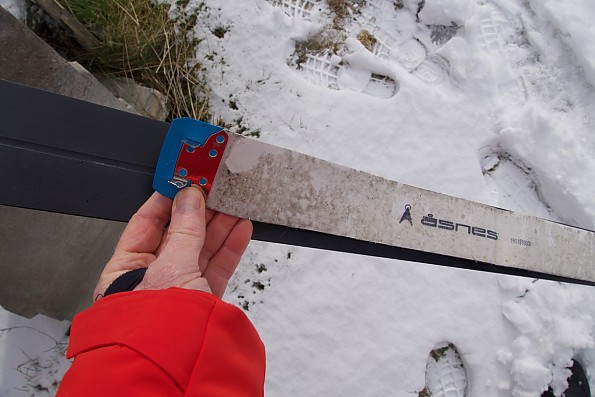Åsnes X-Skin 58mm Mohair
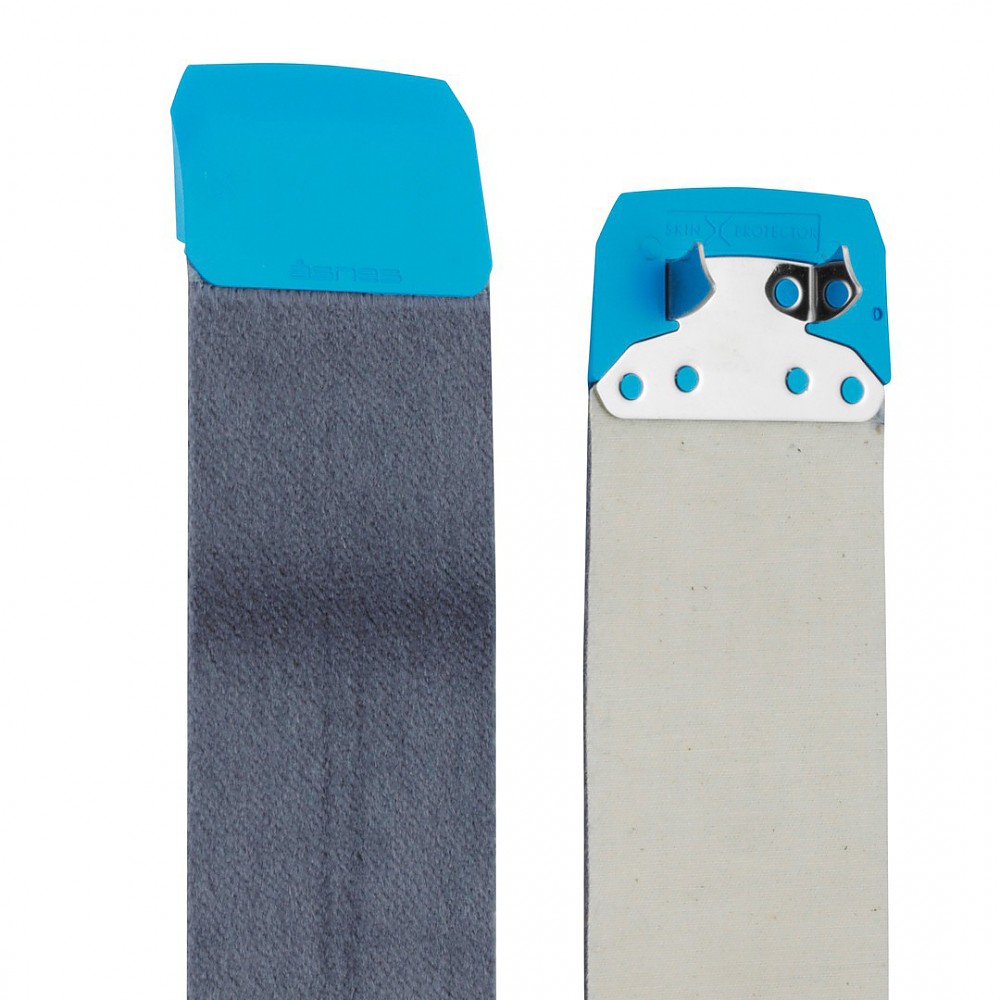
A lightweight, short skin that integrates with Åsnes skis via dependable locking system. Gives a solid kick and moderate climbing power while still allowing some glide on easy terrain, at 1/4 to 1/3 the weight of a full-length skin. Small enough to fit a pair in a chest pocket. Ideal for hut-to-hut trips, and good skiers can take them to the summits.
Pros
- Big weight and effort savings compared to full-length skins
- Climbs well on firm snow, notably corn
- Glue still holds if skins get a little wet
Cons
- Åsnes skis only
- Don't climb well in deep powder
- Should come with skin savers to protect glue
As backcountry or mountaineering skis have gotten bigger, skins have followed along. My full-length skins for my biggest skis, G3 Finder 107s, weigh about 300 g each. Add that to the weight of boot, binding and ski (3.8 kg) and you’ve got 4.1 kg (9 lb) per foot to haul uphill with every step (the good news is that you can slide, not lift). Then that skin weight goes in your pack on the way down.
For skiing steep slopes or in demanding snow, that is more or less necessary if you want to maximize the FQ (fun quotient)—fat skis perform better in a wide range of snow conditions, and for climbing and especially traversing on steep slopes, full skin coverage is needed to prevent backslipping.
 (A range of skins, from over 100mm to the 30 mm X-skins)
(A range of skins, from over 100mm to the 30 mm X-skins)
But then there are those days when there is plenty of powder, and maybe the avalanche risk is up so you’re not going to ski steep anyway. Or maybe you’re doing a peak that is 90 percent mellow skiing in perfect creamed corn conditions. You may find yourself hauling all that foot-weight up the hill step by step and you may ask yourself: “Well, how did I get here? Why am I working so hard to get up this hill when the conditions are so good I could just as well ski and enjoy it on those skinny skis and leather boots I used back in the '80s?”
On those days the FQ can be maximized by going lighter. And one component of a lighter system is skins that weigh in at a fraction of what the big boys weigh. Like, for example, Åsnes X-skins, short skins that provide enough grip for moderate climbing but glide much better than those heavier full-length skins.
These skins only work with Åsnes skis, which have a pair of slots through the ski body ahead of the binding for locking the skin onto the ski base without a tip hook (photos below). The system does not interfere with the use of ski waxes or general purpose full-length skins, so those options remain open.
Åsnes has a broad range of Norwegian style backcountry skis (fjellski), from skinny-fast straight runners to broader and curvier models that can make some nice turns, all of which have the slots and fittings to work with x-skins. Åsnes also produces a line of bigger telemark/randonee skis (topptur ski), which use the wider but oitherwise similar Access version of the X-skins. The Austrian ski giant Fischer has a similar system for its backcountry skis, but the two systems are not intercompatible.
My wife bought a pair of Åsnes Cecilie skis with 45 mm X-skins for our 10-day winter-into-spring hut-to-hut tour last season. The X-skin system has been around for at least 10 years, but this was the first time I had seen it up close, and I was impressed. After we adopted a dog last autumn, I decided I wanted to get some “hunting skis”, which lack steel edges so as to avoid accidentally cutting a dog’s legs (been there, done that), and so went for the Åsnes Kongsvold Jakt, a big-ish backcountry ski with a 66mm waist, along with the 58 mm mohair X-skin. Somewhere along the way we also picked up a pair each of 45 mm nylon and 30 mm mohair versions.
X-skins come in the three different widths noted above and two different types, mohair (gray) and nylon (orange), the former said to provide superior glide, the latter for climbing power and durability. There is also a hot pink 40 mm Race skin (produced for Åsnes by Pomoca rather than Colltex as described below), presumably intended for some variant of rando racing, that is supposed to provide even better glide than mohair. I will review the 58 mm mohair, but will also comment on the other versions that I have used.
Description
Both the mohair and nylon skins are made for Åsnes by the Swiss company Colltex, which has been in the skin trade for over 50 years and invented the first adhesive skin in 1968. In my early telemark days, Colltex was just about the only game in town, but now there are other choices, at least in the full-length skin market. These days skins come in a wide variety of materials and relative weight, including some that are lightened up for rando racing. I haven’t calculated the weight per area of all the different skins, but by heft the mohair X-skins are on the light end. Here is a little comparison table for the skins in the table above (weight per pair):
X-Skins
- 58 mm mohair 116g / 4.1 oz
- 45 mm nylon 101 / 3.6
- 45 mm mohair 88 / 3.1
- 30 mm mohair 62 / 2.2
Other
- 60 mm x 190 cm full-length 438 / 15.4
- Shaped skins for powder skis 610 / 21.5
All the X-skins are sold in a 65 cm length, about right to cover the middle third of a 200 cm ski. Åsnes recommends trimming a few centimeters off of the skin tail to adjust for shorter skis; my 58 mm skins are still original length, the other X-skins have been trimmed a cm or two to fit my wife’s skis. The two full-length pairs have also been trimmed, and shaped in the case of the big ones, to fit the skis I use them with, and have tail hooks that add a little weight. The total weight of my new skis, boots, bindings and 58 mm X-skins is 2.3 kg / 5.1 lb per foot, a little more than half the weight of my big ski rig.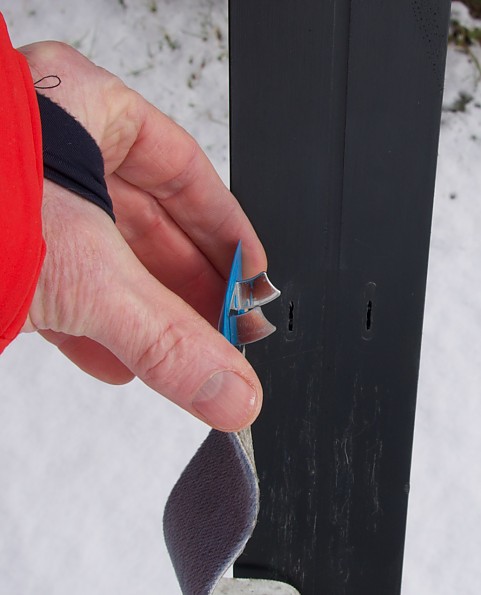
The X-skins go on easily—just peel them open, insert the front fitting into the ski, then center and smooth the skin onto the ski. No fiddling with tail hooks. Åsnes refers to the blue plastic fitting at the front end of the ski as a “skin protector”. The metal tabs on the other side rotate into the slots in the ski and lock in place so that the plastic piece hugs the ski base.
It works; I have not had any snow get in underneath the fitting in snow ranging from powder to corn, nor have I had it work loose. Åsnes also sells 45 mm nylon “Extreme skins” with an all-metal skin protector for durability.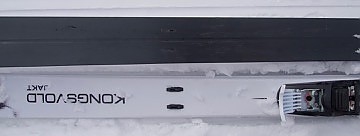

The X-skin system doesn’t rule out using conventional wax. I have had days where I start out on hard wax, put the skins on over the wax for a climb, then go back to wax for the descent and runout. Although I’m not shy about using klister on my light xc skis, it is not so great to put skins on over klister, but then the X-skins can be used to effectively convert the ski into a (slow) waxless ski. I also use full-length skins on the same skis for full climbing power when needed. Ski skins are usually stored by folding each skin in half with glue side stuck together. The skins come in a nifty little zippered case, the same size regardless of skin size and a bit bigger than it needs to be even for the 58 mm skins, but it fits well enough in a pack top pocket. It has a mesh bottom to give the skins a chance to dry out a little when stowed in a pack.
Ski skins are usually stored by folding each skin in half with glue side stuck together. The skins come in a nifty little zippered case, the same size regardless of skin size and a bit bigger than it needs to be even for the 58 mm skins, but it fits well enough in a pack top pocket. It has a mesh bottom to give the skins a chance to dry out a little when stowed in a pack.
 Yet another small advantage of these minimalist skins is that without the case they fit easily in a jacket pocket, a common need for yo-yo skiing.
Yet another small advantage of these minimalist skins is that without the case they fit easily in a jacket pocket, a common need for yo-yo skiing.
Performance
Skin performance has three critical components, which I call Stickum, Kickum, and Slickum: the skin has to adhere reliably to the ski while in use, grab the snow surface to provide uphill grip or forward push, and slide or glide forward easily for skiing efficiency.
Stickum
Skin glue has the same job as the weak adhesive on the back of a post-it note, only way more critical. It has to stick to the ski reliably for the climb but then peel off the ski base cleanly for the descent. Unlike many full-length skins, X-skins do not have a tail hook to help keep the skin in place if it starts to come unstuck. Anyone who has used skins for a couple of seasons knows the teeth-gnashing frustration of trying to climb with a balky skin, especially one without a tail hook so that it relies only on stickum to stay on the ski. So on the X-skin good stickum is especially important.
I’ve logged probably over 100 km on the new 58 mm skins, and on occasion used some of the more-used skinnier ones, and they have all reliably stayed on the ski in both cold/dry and warm/wet snow conditions. 
One good test of a skin’s reliability is in yo-yo skiing, repeated short ascents and descents to “farm” a particularly tasty stretch of powder or corn. With this kind of repeated on-off treatment the skin glue can get dusted with snow, or in wet snow the skins may absorb water and it can be hard to dry the ski base off completely, so that there may be some moisture between skin and ski.
Back in the day it could be just about impossible to get a skin to stick under those kinds of conditions, but newer skin glues perform better. So far the X-skins have passed all those tests, with no peeling even on a recent yo-yo foray in soggy snow at a closed alpine ski area.
After folding and storage, skins should also peel apart cleanly, if not easily, so that they can be applied to the ski. It’s tempting to say that the Colltex glue is too sticky, not because it sticks too much to the ski, but because when you fold the skin back on itself for storage, then peel open again, the glue sticks to itself so well that patches of glue may peel off the backing.
This can be remedied by using skin savers, strips of plastic netting that go between the folded halves of the skin to prevent that kind oversticking and make much it easier to peel the skins apart (on the big G3 skins in the first photo). These are sometimes provided or sold separately for big skins, because peeling open a 100+mm skin can be an unwelcome isometric challenge, especially in any kind of unfriendly weather when you just want to get going. I have tried making my own out of a couple different materials, but haven't yet found anything the works. I think Åsnes would do well to provide skin savers with all its X-skins to help protect the glue.
No skin glue lasts forever, so refreshing or replacing glue is a necessary part of skin maintenance. Åsnes isn’t clear about which of its adhesives Colltex uses on these skins, but it is probably their “hot-melt” glue, which Åsnes sells as replacement glue on their website. It does not use any nasty organic solvents like skin glues of yore. In those days, redoing a pair of skins in any enclosed space could be an unwelcomely intoxicating experience, with fumes leaking up into the house from the basement and lingering for the rest of the day as the glue dries out. Kudos to Colltex and others for coming up with a better way.
The small surface area of the X-skins is another advantage here—a single tube of replacement glue might be just enough to cover one pair of big skins, but should easily do several pairs of X-skins. (For big skins, there is also an iron-on glue replacement process, which is a lot easier and cleaner, but I don’t see it offered for the X-skins, maybe not so much of an issue because they are so much smaller.)
Kickum
I’ve used the X-skins on flat stretches of groomed ski trails, out of the tracks because my skis are too wide, and on hill climbs in machine packed, windpack, powder, corn, and mashed potato snow. In the firmer conditions, the 58 mm skins give enough bite to climb at angles up to about 20 degrees, even a little more on a firm corn snow surface where the coarse grains give plenty for the skins to grab onto. That angle comes down in light powder snow, which gives way under the weight of the ski.
For extended climbs in loose snow, I want full-coverage skins. I have not done much traverse climbing using these skins, another place where full coverage is important, at least on hard snow, because on an edged ski less of the ski base/skin engages the snow. I would not expect them to perform well for setting new travers tracks in harder snow, not only because of the short length but because they aren’t quite wide enough to cover the full width of the ski, especially away from the waist. They should be fine for cutting new tracks in soft corn snow or climbing in established tracks at climbing angles under about 20˚. On the flats, the skins give a solid kick even with lazy technique. A properly waxed ski usually requires “snap”, a well-timed kick and weight transfer, to engage the snow, and the same goes for any reasonably high performance skin-ski, but with these and any other skins on backcountry skis that don’t have much of a wax pocket you can just shuffle along easy. Maximum efficiency is probably not what you’re after on this kind of kit anyway.
On the flats, the skins give a solid kick even with lazy technique. A properly waxed ski usually requires “snap”, a well-timed kick and weight transfer, to engage the snow, and the same goes for any reasonably high performance skin-ski, but with these and any other skins on backcountry skis that don’t have much of a wax pocket you can just shuffle along easy. Maximum efficiency is probably not what you’re after on this kind of kit anyway.
For a routine hut-to-hut trip these might be the only skins I’d need, but since I’m usually looking to bag peaks along the way I’d probably want a pair of full-length skins along as well. That’s what I had planned for our seven-day pre-Easter trip this season before its unavoidable cancellation.
Slickum
The business side of the skin is 100 percent mohair, the same natural fiber used in high-quality outdoor clothing, which is preferred for its superior glide. Åsnes says the nylon version has better grip and is more durable, but in my experience mohair skins have plenty of grip and last for years, so I’ll go for the glide. On flat, firm snow, my 96-66-85 Åsnes Kongsvold skis with the 58 mm skins will glide a short distance with shuffle-style kicking effort, somewhere in between the smooth glide of a waxed ski and the non-glide of a full-length skin. More importantly, the minimalist X-skin requires less effort than a full-length skin to slide forward when climbing, which can be a big energy saver in the long run.
To compare the 58 and 30 mm widths I went for a 10 km tour using one of each. The 30 mm mohair skins glide a bit better, and climb surprisingly well in soft, wet corn snow, but I expect more of a difference would emerge in harder or drier snow conditions. When in doubt, I’ll go with the 58s, but I suppose an alternative for wet spring conditions would be to use the 30s for efficiency in valley bottoms and on easy climbs, with a pair of full-length skins for getting to summits.
I also took a test drive with one 45 mm mohair skin and a 45 mm nylon one, this time after a fresh dump of powder. On packed powder on the groomed trails, the difference was not subtle—the nylon skin had almost no glide, while the mohair skin would glide forward a few tens of cm with shuffling gait. More importantly, the nylon skin offered more resistance when sliding the ski forward while climbing, adding to the work of moving uphill.
Those differences diminished in a few cm of new snow over the base, and even more so when breaking trail in new powder. I didn't notice much difference in climbing power during this foray. I am not so impressed by the performance of the nylon skins, but they are supposed to be more durable so I suppose they might be a reasonable choice on very long tours in abrasive conditions or in mostly loose snow. I know that Åsnes skis and accessories are used by Norway's cadre of arctic/antarctic explorers, such as Børge Ousland, Liv Arnesen, and Rune Gjeldnes, and they may well go for nylon.
Best use
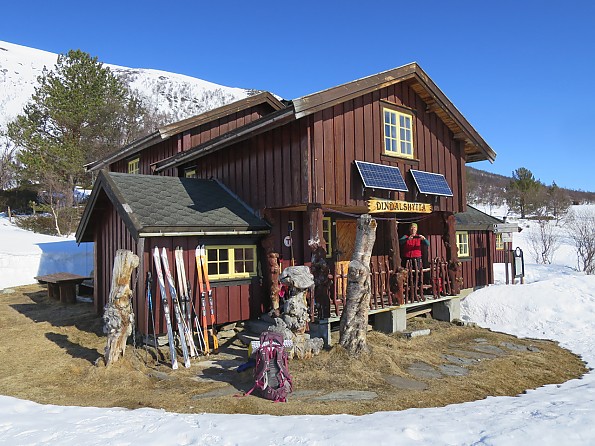 Paired with an Åsnes ski of your choice, the X-skin system is ideal for Norwegian style hut-to-hut skiing, which typically involves following a valley up to its head and then going over a not-to-steep pass to descend a valley to the next hut. Experienced skiers can extend its use to include peak bagging and fast descents up to some type of Type II Fun limit.
Paired with an Åsnes ski of your choice, the X-skin system is ideal for Norwegian style hut-to-hut skiing, which typically involves following a valley up to its head and then going over a not-to-steep pass to descend a valley to the next hut. Experienced skiers can extend its use to include peak bagging and fast descents up to some type of Type II Fun limit.
I have made dozens of delightful descents in Norway on the kinds of relatively light, narrow skis in the Åsnes backcountry lineup, many as side trips on extended hut-to-hut tours. The addition of these lightweight, efficient skins can make those kinds of days that much easier and smarter. At the other end of the scale, the system might be a great choice for people who just want to poke around the woods behind the cabin after a fresh snowfall.
Background
I have been using skins of one size or another for most of my backcountry skiing life, almost 40 years. I have been using the X-skins for about six weeks, on a mix of groomed xc trails (for access to off-piste) and hut-based mountain tours in powder, windpack, mashed potato, and corn snow conditions.
Source: bought it new
Price Paid: NOK 599 (about $60 to $75 depending on exchange rate, including 25% VAT)


